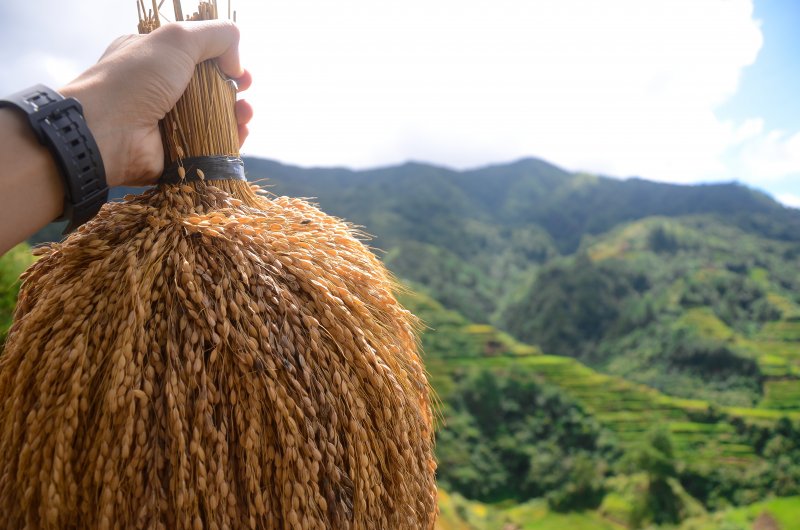The odds were against me. I didn’t speak their language. I was new to their area. And here I was interrogating them about their humble lifestyle and household income. No matter the circumstance, I was hell-bent on seeking the rationale behind the dire situation of farmers in Banaue, Ifugao, especially those who, despite earning a higher salary (if you can even call it that) than any farmer in the country, still find themselves stuck in a financial rut.
Fascinating findings
I went to the Cordilleras to study the Rice Terrace Farmers’ Cooperative (RTFC), which aims to empower farmers and help them acquire the skills and tools necessary to become competitive in the local and foreign markets as well as discover its effect and influence on the social welfare and economic development of farmers. The focal point of my study is the field research that was designed to understand the families’ incomes by comparing it to the provincial averages.

My hypothesis was that, like energy, money can neither be created nor destroyed; it can only transform. Since access to finance was low and the household savings of most families are low to zero, understanding how they spend will more or less be an accurate stand-in for their income.
Coming from an accounting firm, I’m used to studying income statements that were as neat as they come. Never in my wildest dreams did I think that I would have to count food items as expenses. To put it into perspective, some typical answers I got to the question “How much money do you spend on food consumption per month?” were “Hmm, about 15 kilos of rice, four chickens, a kilo of tuyo, and three kilos of vegetables.”
Suffice to say, my valuation skills were put to the test. They had no idea how much they spent and I had to somehow rationalize their monetary expenditure. The way I chose to do so was to value it as an opportunity cost.
Further studies reveal that farmers would set aside rice for their families’ consumption first, and then sell anything that is left over. A thought that quite puzzled me. Why not sell all cavans of harvested rice, buy cheaper rice at half the price, capitalize on the margins, and gain all potential income?
The most surprising expenditure they had was rice and this was a pivotal moment in my study. These farmers make the most out of any farmer in the country at the farm gate where the price for the sale of produce comes direct from the producer. They make more than double what a typical farmer makes per kilogram of rice.
Further studies reveal that farmers would set aside rice for their families’ consumption first, and then sell anything that is left over. A thought that quite puzzled me. Why not sell all cavans of harvested rice, buy cheaper rice at half the price, capitalize on the margins, and gain all potential income? If they had such a high value crop and if they were living in poverty, why forego the extra income? To my financial mind, it just did not make sense.
To add to that, the Cordillera Administrative Region has one of the highest poverty incidence rates in the country, and for the most part, this is the driving force behind the abandonment of farming, albeit traditional culture, among the youth. The depressed social conditions have forced farmers into situations where they are left with one of two choices: either they transition out of heirloom rice since a market for it didn’t exist and grow modern high-yielding varieties or they abandon their farms altogether.
Consequently, migrating to cities in search of higher wages has indirectly led some of the traditional heirloom rice varieties to extinction. The abandoned farms are also beginning to erode, which are causing serious damage to the terraces.
Organizational structure
With the advent of technology and continuous strides in agricultural sciences, traditional rice varieties have become economically unfeasible to produce. Ironically, in a country where a meal isn’t complete without rice, the market for high-quality, heirloom rice varieties is almost non-existent.

To address this problem, Revitalize Indigenous Cordilleran Entrepreneurs (RICE) Inc. was created with the mission of preserving heirloom rice and promoting the culture of community rice production. To this end, RICE Inc. helped establish the RTFC, which aims to empower farmers and help them acquire the skills and tools necessary to become competitive in the local and foreign markets.
“If it’s not good enough to feed to my family, then it is definitely not something worth selling,” Jimmy Lingayo, manager of the RTFC, mentioned in one of my interviews.
From its humble beginnings in 2005, exporting only 800 kilograms of samples to the U.S., the RTFC has increased its exports to 18.5 metric tons in 2014. Apart from helping farmers export, RICE Inc. has helped rehabilitate farms devastated by calamities and natural disasters through the Adopt-a-Terrace initiative by connecting local and international donors to small-holder farmers.
The project also aims to address the continuing extinction of heirloom rice varieties by managing a seed bank meant to preserve the genetic diversity of the rice varieties in the Cordilleras.

“If it’s not good enough to feed to my family, then it is definitely not something worth selling,” Jimmy Lingayo, manager of the RTFC, mentioned in one of my interviews. This all made sense to me now. Being able to grow rice the way their ancestors did was a source of pride and value to these farmers. This is one of the grounding principles of their society.
Social capital is defined by the Organisation for Economic Cooperation and Development (OECD) as “networks together with shared norms, values, and understandings that facilitate cooperation within or among groups.” In this case, we can think of networks as cultural links between farming groups or individuals.
The often forgotten dimension within human development is social capital. Traditionally, growth models have been restricted to natural, physical, and human capital.
The RTFC is a tangible manifestation of how individual farmers have capitalized on social capital. It allows individual farmers to collectively act as a singular entity to sell to local and foreign buyers. However social capital cannot thrive without institutional support. Through the intervention of RICE Inc. and the Department of Agriculture, RTFC training sessions and mechanized rice mills have enabled farmers to grow higher quality rice that adheres to local and foreign standards.
The RTFC has turned traditional social development logic on its head and offers us an alternative. The project envisions a sustained and enhanced production of quality organic rice while nurturing a balanced ecosystem of traditional and modern cultures.
A role model in Cordillera
We could all take notes from the RTFC blueprint. It is inclusive; it listens to the needs of farmers but is grounded and realistic. The RTFC was started because the Cordillera farmers, on their own, do not have the capacity to cater to either the domestic or the foreign markets. They have also changed with the times, as they are now using rice mills and other machinery to enhance their production, but they still grow rice the same way their ancestors did 2,000 years ago—pesticide- and chemical-free. Most importantly, they have not forgotten the bond that underpins their culture: rice growing.
The often forgotten dimension within human development is social capital. Traditionally, growth models have been restricted to natural, physical, and human capital. My time with different tribal groups and Cordillera farming communities helped me realize that these types of capital only partially determine the process of economic growth. These dimensions overlook the way in which participants interact and organize themselves to generate growth and development.
The founders of the heirloom rice project struck the right chord because they took into consideration the development of social capital. It is often overlooked that more than a dozen ethnic groups inhabit the Cordilleras, each with their own cultural identities and languages.
The RTFC as an enterprise has delivered results in less than a decade. Facing the threat of abandonment, the rice terraces have been given a new lease on life. By understanding their culture and the norms and customs that surround it, the RTFC was able to capitalize on the one thing that these farmers have been good at for thousands of years.
Originally published in F&B Report Vol. 13 No. 4





